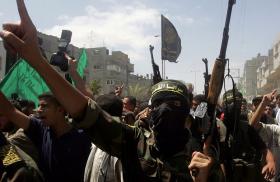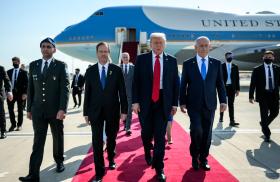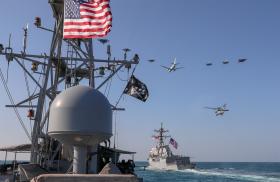Over the past month, the Israel Defense Forces (IDF) conducted a large-scale operation in several cities and refugee camps in the West Bank and Gaza Strip, beginning on the night of February 27 and ending nearly three weeks later with the withdrawal of Israeli troops from Bethlehem and Bet-Jalla on March 18. This operation was unique in several ways: the scale of activity was the largest of the current conflict; it included simultaneous action in several areas in the West Bank and Gaza Strip, using ground, air, and naval forces; and it included massive penetration into areas under full Palestinian control (Area A) and, most notably, into refugee camps, long considered almost out-of-bounds for security forces (even those of the Palestinian Authority [PA]). A careful look at the operation and its outcome, however, shows that the rationale behind it does not represent a shift in Israeli military strategy, but merely a more robust implementation of it.
Objectives of the Operation
There were five central objectives to this wide-ranging operation:
1. Strike at the terrorist infrastructure: activists, weapons (including the new short-range Kassam rockets), tunnels for smuggling weapons on the Rafah-Egypt border, laboratories for the manufacture of explosives, and so forth. This sort of direct attack reflects an Israeli understanding that putting military pressure on the PA so that they will in turn put pressure on terrorist organizations has a limited impact.
2. Undermine the perception of the refugee camps as safe havens for terrorists, impenetrable to the IDF.
3. Strike at PA facilities, especially those of the Fatah-Tanzim, thus demonstrating the PA's responsibility for terrorist activity in its territory.
4. Maintain temporary control over territory. Midway through the operation, as U.S. emissary Gen. Anthony Zinni was expected to arrive, the IDF looked to hold onto these territories so that they could be traded for Palestinian security measures.
5. Deter terror, setting a price for terror attacks such as the suicide bombing of a synagogue in Jerusalem's Bet-Yisrael neighborhood and the firing of Kassam rockets into Sderot, a southern town inside sovereign Israel.
The first and second objectives were addressed by entering the refugee camps themselves—despite the serious tactical difficulties—and by conducting widespread arrests in villages and towns. Air strikes were also used against Tanzim offices and workshops for manufacturing Kassam rockets in the Jebalia refugee camp in the Gaza Strip. The third objective of striking at the PA was met mainly through air attacks, but also through sea-based strikes on targets in the Gaza Strip. Moreover, taking control of Ramallah, the PA's administrative capital in the West Bank, and encircling the government buildings (and Arafat himself) sent an important and direct message to the PA and its leader. The fourth objective, in anticipation of the arrival of General Zinni, was addressed by leaving forces on the outskirts of towns even after withdrawing from the towns themselves. In fact, no withdrawal of any sort was ordered in Bethlehem and Bet-Jalla at the time, which provided Israel with bargaining chips to use when Zinni arrived.
Tactical and Operational Aspects
According to Israeli newspapers, the offensive was carried out by several joint task forces based on infantry and armored units, but also included special forces, engineer corps, and intelligence units, as well as liaison officers who conducted the contacts with local Palestinian officials. In specific cases, helicopter gunships were used in support of the ground troops. In total, it is estimated that several thousand troops took part in the operation, with two to three hundred tanks alongside the air and naval forces.
Tactically, the operation depended on a concentrated intelligence effort to pinpoint targets: the residences of terrorists, laboratories for the manufacture of explosives, stores of weapons and ammunition, and locations of workshops for Kassam rockets. In the camps and towns, the operation began with rapid deployment and seizure of strategic locations before imposing full curfew, which enabled the forces to conduct searches in accordance with the guidelines provided by intelligence. Finally, the forces left the camps and towns well before circumstances would have required them to take responsibility for civilian aspects of life.
In dealing with the tactical complexities of operating in refugee camps—including dangers to Israeli soldiers as well as to civilians who could be caught in the crossfire—the forces avoided passing through the narrow streets, which were laden with prepositioned explosive devices and snipers. Instead, while the armored vehicles passed through the streets, the infantry passed from house to house by breaking through walls. Indeed, dozens of antipersonnel devices were employed against Israeli forces in the camps, yet the damage to Israeli troops was small. In addition, the Palestinian security forces were warned in advance so as to avoid confrontation.
Outcome of the Operation
The operation produced several tactical successes: the IDF captured a few dozen Kassam rockets; it destroyed some ten Kassam-producing workshops; it located and destroyed a few dozen explosive devices that were ready to be used in suicide bombings; it apprehended several dozen low- and medium-level terrorist activists (after interrogating and releasing several hundred others) and killed several dozen more; and it captured several hundred weapons and a large amount of ammunition. In a further, nonmaterial achievement, Israel gained an opening position that forced the Palestinians to assume responsibility for any area from which the Israelis withdrew.
The effect of such results on the level of terror, although significant, is only short term. One must bear in mind that this sort of operation cannot—and is not meant to—solve the problem of terrorism decisively. It is rather a kind of "maintenance" in an ongoing, asymmetrical war of attrition. For example, this operation did not harm the "terrorist infrastructure" in the sense of diminishing the willingness of hundreds and even thousands to fight on. In fact, the outcome of such an operation is to enhance such willingness; Palestinian public opinion and media have reflected this attitude in the last few days.
As mentioned above, the rationale behind the operation is in fact the same one that has guided IDF operations within the last seventeen months of conflict. The stated IDF goal in this conflict is to prevent the Palestinians from gaining any political advantage by way of violence. In such an asymmetrical war of attrition, there can be no decisive military subduing of the enemy. According to the IDF approach, however, the cumulative effect of many tactical engagements over a long period can influence the Palestinian perception of what can and cannot be achieved through violence. However, it can also influence the Israeli public's perception of the limited effectiveness of the use of force. In this context, more such large-scale operations may well occur in the future, combining "maintenance" of the level of terrorism, retaliation for specific terror attacks, and counterbalance for Israel's softening on certain positions.
Col. Nitsan Alon (Israel Defense Forces) is a visiting military fellow at The Washington Institute.
Policy #369


